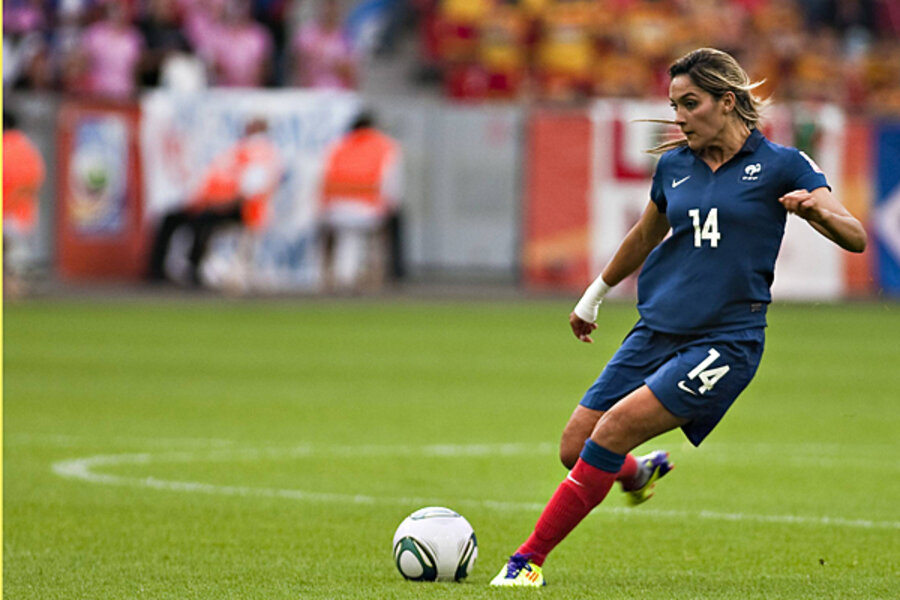USA vs. France: How Women's World Cup 2011 could be game-changer
Loading...
When the women of the United States national team line up against France in the semifinals of the Women’s World Cup Wednesday, they could well be looking at the future of women’s soccer.
And that future could look a lot different than anything that has come before.
The American team is, in many ways, pleasantly familiar to those who might have taken a 12-year siesta from women’s soccer. Like the US women of 1999, the women of 2011 are strong, they are fierce, they are athletic, and their will to win could be measured on the Richter scale.
So raw and visceral is goalkeeper Hope Solo’s determination that it would seem she needs to be kept in a cage between matches.
In France, however, the US will be facing a team with a completely different competitive DNA. They aspire to be artistes in the truest French tradition – sculptors of goals, divas of defense.
And of all the developments in an already-historic World Cup, this surely is among the best: The hegemony of a few teams dominating the game is ebbing away as more countries around the world embrace the women’s game. As a result, a new class of countries has the opportunity to leave their mark on the sport, increasingly bringing the intoxicating potpourri of national styles that seasons the men’s game into women's soccer, too.
Both Wednesday’s semifinals will pit the old versus the new order.
In game No. 1, the US represents the robust style that has dominated women’s soccer since the inception of the World Cup in 1991 – a sort of soccer Darwinism in which only the fitter, faster, and stronger thrives. The French style, in some respects, is a repudiation of that world view, slowing the action down and looking to open opposing defenses through more subtle interplay and greater on-the-ball skills.
In game No. 2, traditional power Sweden will play the part of the old guard, opposed by upstart Japan, which is arguably the most technically proficient team in women’s soccer.
Wednesday is a potential hinge-point in women’s soccer – a moment when teams playing in ways unfamiliar to the women's game could overturn those who have set the standard for more than a generation.
Brazil began the revolution eight years ago when it introduced the sport to samba football, in which soccer becomes a 90-minute carnival. Japan took another step when it ousted world No. 1 Germany in the quarterfinals last weekend. And now France and Japan will try to complete that revolution and become the last teams left standing.
Even if they fall short, this tournament has laid the foundation for the changes ahead. It has marked the end of a beat-down era, when the tournament’s lesser teams essentially took to the field with “kick me” signs taped to their backs and hopes only of avoiding scorelines that would invoke the “mercy rule” in Little League Baseball.
Teams like France and England and Australia – previously competitive mulch to fill out the brackets – have come into their own. First-timers Equatorial Guinea arrived and managed not to look like a puppy trying to cross the interstate.
The most lopsided game in the group stage this year was 4-0. In 2007, Germany beat Argentina 11-0.
It is, in some ways, a world that the US women have wrought.
The 1999 World Cup here was a revelation, not only to the US, but to the world – sold-out stadiums, big television ratings, and women’s sports pushed to new heights.
In short, it was contagious. The virtues of Title IX, the American law that mandates equal spending on men’s and women’s sporting programs at public schools, got an international airing.
“The lessons of Title IX have filtered around the world to varying degrees in the past decade,” writes Sports Illustrated’s Ann Killion. “Countries that routinely ignored their women's teams have directed resources, energy, and a certain amount of pride toward their women's teams.”
Similarly, some of Europe’s premier professional men’s soccer clubs, flush with cash, have gotten in on the action, starting women’s teams. Ten of the 26 women on the French national team – and half of its 11 starters – come from Olympique Lyonnais, a dynasty in French men’s Ligue 1. In response, archrival Olympique Marseille (OM) started its own women’s team.
This has broken down cultural barriers to women playing soccer, says French Head Coach Bruno Bini: "A girl might say to her father, 'Papa, I want to play soccer.' He's going to respond, 'No, it isn't a sport for girls.' But if she says, 'Papa, I want to play for OM,' he will say yes because she isn't playing soccer, she is playing for OM. Even the most macho parents can do nothing about it."
That growing acceptance is why France’s Louisa Necib will be playing Wednesday. A midfielder who roams the field like a bird of prey, seeking to spring teammates free on goal with intuitive passes, her style is the spontaneous expression of an ingenious soccer soul. “There’s so much sunshine when she does touch the ball,” says Bini.
But if her father had had his way, Necib would have given up soccer for gymnastics – something more suitably feminine, he thought. Now, he calls her skill “a gift from God.”
In Germany, it has been a gift to soccer fans – proof that, 20 years after the Women’s World Cup began, the women’s game is making significant strides toward becoming the world’s game.





